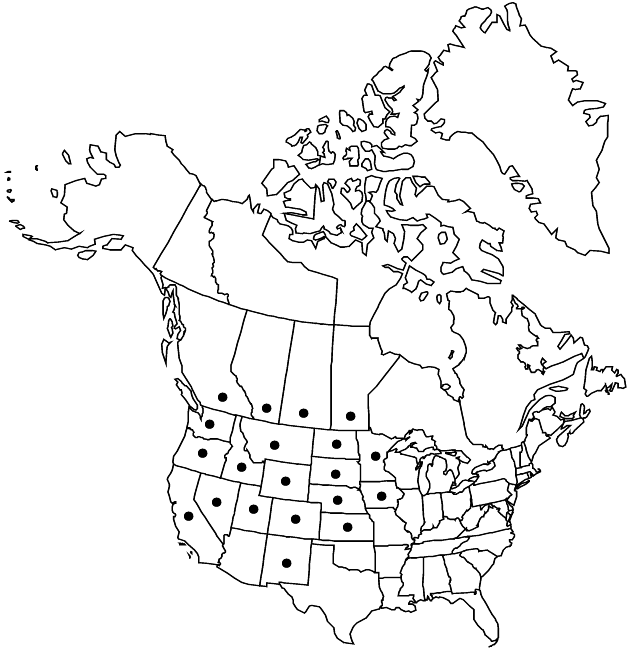Difference between revisions of "Senecio integerrimus"
Gen. N. Amer. Pl. 2: 165. 1818.
FNA>Volume Importer |
RevisionBot (talk | contribs) m (Bot: Adding category Revised Since Print) |
||
| (5 intermediate revisions by 3 users not shown) | |||
| Line 6: | Line 6: | ||
|place=2: 165. 1818 | |place=2: 165. 1818 | ||
|year=1818 | |year=1818 | ||
| + | }} | ||
| + | |special_status={{Treatment/ID/Special_status | ||
| + | |code=F | ||
| + | |label=Illustrated | ||
| + | }}{{Treatment/ID/Special_status | ||
| + | |code=E | ||
| + | |label=Endemic | ||
}} | }} | ||
|basionyms= | |basionyms= | ||
| Line 19: | Line 26: | ||
-->{{Treatment/Body | -->{{Treatment/Body | ||
| − | |distribution= | + | |distribution=Alta.;B.C.;Man.;Sask.;Calif.;Colo.;Idaho;Iowa;Kans.;Minn.;Mont.;N.Dak.;N.Mex.;Nebr.;Nev.;Oreg.;S.Dak.;Utah;Wash.;Wyo. |
|discussion=<p>Varieties 5 (5 in the flora).</p><!-- | |discussion=<p>Varieties 5 (5 in the flora).</p><!-- | ||
--><p>The varieties of <i>Senecio integerrimus</i> are distinguished by morphology and geography.</p> | --><p>The varieties of <i>Senecio integerrimus</i> are distinguished by morphology and geography.</p> | ||
| Line 68: | Line 75: | ||
-->{{#Taxon: | -->{{#Taxon: | ||
name=Senecio integerrimus | name=Senecio integerrimus | ||
| − | |||
|authority=Nuttall | |authority=Nuttall | ||
|rank=species | |rank=species | ||
| Line 75: | Line 81: | ||
|basionyms= | |basionyms= | ||
|family=Asteraceae | |family=Asteraceae | ||
| − | |distribution= | + | |distribution=Alta.;B.C.;Man.;Sask.;Calif.;Colo.;Idaho;Iowa;Kans.;Minn.;Mont.;N.Dak.;N.Mex.;Nebr.;Nev.;Oreg.;S.Dak.;Utah;Wash.;Wyo. |
|reference=None | |reference=None | ||
|publication title=Gen. N. Amer. Pl. | |publication title=Gen. N. Amer. Pl. | ||
|publication year=1818 | |publication year=1818 | ||
| − | |special status= | + | |special status=Illustrated;Endemic |
| − | |source xml=https:// | + | |source xml=https://bitbucket.org/aafc-mbb/fna-data-curation/src/2e0870ddd59836b60bcf96646a41e87ea5a5943a/coarse_grained_fna_xml/V19-20-21/V20_1230.xml |
|tribe=Asteraceae tribe Senecioneae | |tribe=Asteraceae tribe Senecioneae | ||
|genus=Senecio | |genus=Senecio | ||
| Line 86: | Line 92: | ||
}}<!-- | }}<!-- | ||
| − | -->[[Category:Treatment]][[Category:Senecio]] | + | --> |
| + | |||
| + | [[Category:Treatment]] | ||
| + | [[Category:Senecio]] | ||
| + | [[Category:Revised Since Print]] | ||
Latest revision as of 19:28, 6 November 2020
Perennials (possibly biennials), (10–)20–70 cm (caudices buttonlike, roots fleshy-fibrous). Herbage arachnose, loosely tomentose, or villous (hairs crisped, jointed), glabrescent. Stems single. Leaves progressively reduced distally; ± petiolate; blades elliptic, lanceolate, linear, oblanceolate, rounded-deltate, or suborbiculate, 6–25 × 1–6 cm, bases ± tapered or truncate to cordate, margins entire or ± dentate (distal leaves sessile, bractlike). Heads 6–20(–40+) in corymbiform arrays (peduncle of terminal head often shorter than others). Calyculi of 1–5+ linear to filiform bractlets (seldom more than 2 mm). Phyllaries usually ± 13 or ± 21, rarely ± 8, (4–)5–12(–15) mm, tips usually black, sometimes green. Ray florets usually ± 8 or ± 13, sometimes 0; corolla laminae 6–15(–20) mm (usually yellow, ochroleucous to white in one variety). Cypselae usually glabrous, sometimes hirtellous (mostly on angles). 2n = 40, 80.
Distribution

Alta., B.C., Man., Sask., Calif., Colo., Idaho, Iowa, Kans., Minn., Mont., N.Dak., N.Mex., Nebr., Nev., Oreg., S.Dak., Utah, Wash., Wyo.
Discussion
Varieties 5 (5 in the flora).
The varieties of Senecio integerrimus are distinguished by morphology and geography.
Selected References
None.
Lower Taxa
Key
| 1 | Basal leaves with distinct petioles, blades usually ovate to rounded-deltate, sometimes obovate to oblanceolate; ray corollas white or ochroleucous | Senecio integerrimus var. ochroleucus |
| 1 | Basal leaves with or without distinct petioles, blades elliptic, lanceolate, oblanceolate, rounded-deltate, sublinear, or suborbiculate; ray corollas yellow (or rays 0) | > 2 |
| 2 | Herbage glabrous or glabrate at flowering (except in leaf axils and among heads); phyllaries linear-subulate, tips usually green, minutely (if at all) black | Senecio integerrimus var. integerrimus |
| 2 | Herbage usually arachnose, tomentose, or villous at flowering; phyllaries lanceolate to linear-subulate, tips black (if minutely so, then narrowly lanceolate and broader than subulate) | > 3 |
| 3 | Basal and proximal leaves oblong or lanceolate to sublinear; heads 3–6(–16+); phyllaries 10–15+ mm | Senecio integerrimus var. scribneri |
| 3 | Basal and proximal leaves mostly elliptic to oblanceolate, sometimes elliptic or rounded-deltate to suborbiculate; heads usually 6–15(–30+; if fewer than 6, leaves lanceolate or broader); phyllaries 5–12 mm. | > 4 |
| 4 | Plants copiously arachnose, tomentose, or villous at flowering; phyllaries linear-subulate, 8–12 mm, tips minutely, if at all, blackened | Senecio integerrimus var. major |
| 4 | Plants copiously to sparsely arachnose, tomentose, or villous at flowering; phyllaries mostly lanceolate (seldom as narrow as linear-subulate), 5–10 mm, tips black | Senecio integerrimus var. exaltatus |